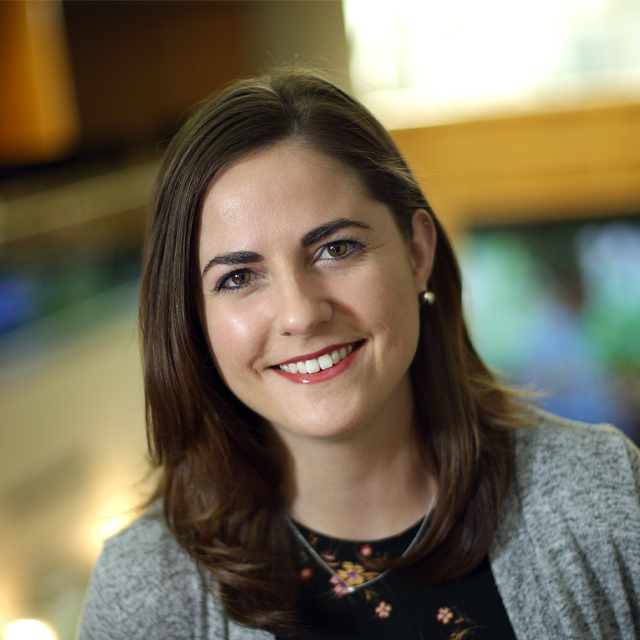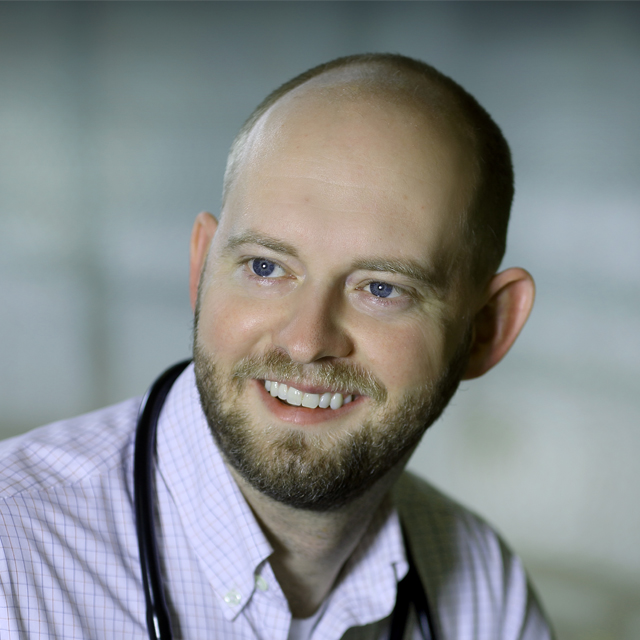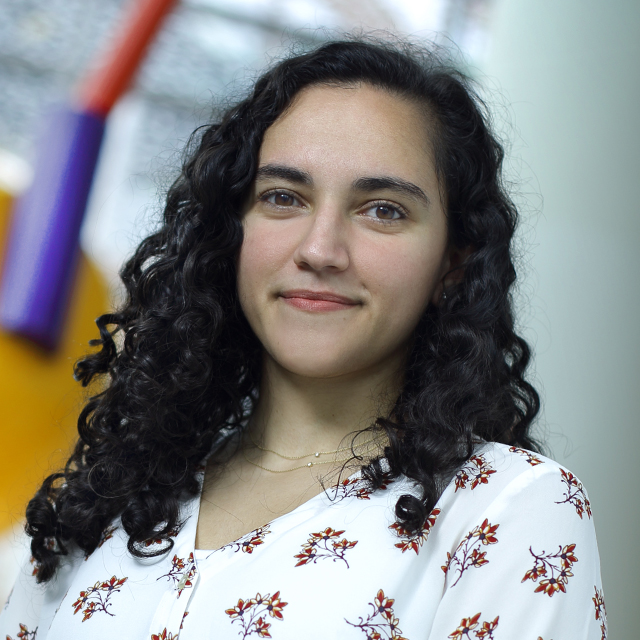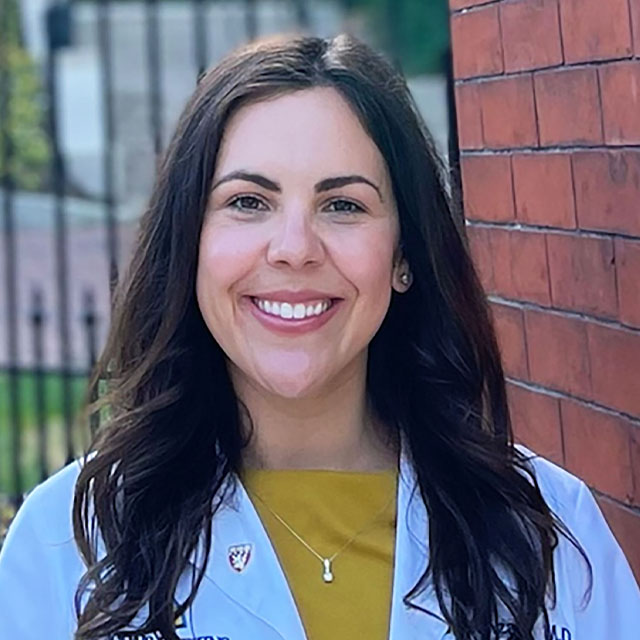
Photo by Keith Weller
Jade Cobern
Tuba City Regional Health Care Corporation | Tuba City, Arizona
Rotations in August 2019 and October 2019
Currently in General Preventive Medicine
Residency, Class of 2023
Doing her rotations before COVID-19, Cobern worked with young patients who faced metabolic disorders, mainly prediabetes and type 2 diabetes. But these children lived hundreds of miles away from the specialists who could supplement their care. The nearest endocrinologist was in Phoenix, Arizona, 250 miles away.
“The distances were such a difficult barrier,” says Cobern.
She found herself working on a telehealth project that served young patients with autism spectrum disorder, which involved videoconferencing between patients, their families, the Tuba City attending physician and specialists at Children’s Hospital of Philadelphia, toward the goal of doing an assessment for the patient.
She realized that telehealth could play a role in care for patients on insulin, too, and got involved in a push to expand telehealth to endocrinology. The pandemic has delayed the telehealth contract, but physicians there are still working on it.
While in Tuba City, she learned much about the Navajo community and how members take care of each other. “There’s a lot of shared care for members of the community. Someone might call someone their cousin-brother or cousin-sister. They’re not biologically related, but they share a family structure,” she says. “There’s a strong sense of care for that child.”
In the end, her rotation helped to solidify her interest in health disparities and inspired her to take a systems approach using a human rights lens. Cobern is currently a general preventive medicine resident at the Johns Hopkins Bloomberg School of Public Health. She’d like to apply her experience to health policy, either in state legislatures or federally.
“I would love to work in some capacity that connected to the Navajo population,” she says. “It’s such a unique population, and I was very lucky to experience their culture and way of life. It helped shape my perspective of medicine and a way of caring for each other.”

Photo by Keith Weller
Zac Zabriskie
Tuba City Regional Health Care Corporation | Tuba City, Arizona
Rotation in August 2021
Currently a third-year pediatric resident at Johns Hopkins
During Zabriskie’s rotation, there was a slight lull in the COVID-19 pandemic, and he says the response of the Navajo Nation to the pandemic was more robust than what he’d seen elsewhere. “There were curfews in place. There were mask mandates in the Nation. A lot of people saw family members get very sick, very early, with underlying health conditions like diabetes. But there was a very good vaccine rollout. People got vaccinated at higher rates than we did in Baltimore.”
Of course, the pre-pandemic health problems still existed, and Zabriskie found himself doing quite a bit of obesity counseling, noting that the poverty experienced by many of his patients makes it difficult for them to eat healthy meals. As for cooking meals at home, Zabriskie says, “I had to ask if there’s running water and electricity in the home, and there were a significant portion of patients who don’t have that.”
Zabriskie also faced more cases of dental cavities than he was accustomed to, which requires the physicians to focus on oral health.
“I counseled people on wearing helmets on bikes and dirt bikes, or when riding in the backs of trucks,” says Zabriskie. “I emphasized seat belts because there are a lot of car crashes.”
According to the Indian Health Service, unintentional injury mortality rates for people living on or near federal reservations are approximately 2.5 times higher than the combined all-U.S. races rate, although there has been progress in reducing that rate over the last several years.
Zabriskie’s work in Tuba City introduced him to physicians who’ve been there for 30 years and at this point are taking care of their patients’ children. He will most likely apply to a subspecialty such as cardiology, but primary care tugs on his heart. “There’s such a degree of trust and connection built in primary care,” he says.

Photo by Keith Weller
Yasamin Sanii
Northern Navajo Medical Center | Shiprock, New Mexico
Rotation in December 2021
Currently a second-year pediatric resident at Johns Hopkins
Sanii notes that when COVID-19 unfolded, the vulnerable populations in Tuba City and Shiprock with already precarious health situations were hit hard. From April 2020 to June 2021, more than 140,000 children living in the United States lost a parent or grandparent caregiver to the virus. The Native American population was one of the ethnic minority groups to bear the highest burden of COVID-19-related orphanhood.
“A lot of kids came in with a new guardian because of parents who passed,” Sanii says. “This population had the highest rates of orphanhood. I had to be clear when meeting kids and clarify who the guardian was,” she says, but notes that the because of the Navajo community’s collective approach to child care, even the orphaned patients had someone looking after them.
She saw patients with a lot of mental health issues as well as speech or developmental delays.
“Online school prevented kids from having their normal outlets and support services, which led to an increase in mental health issues,” she says. Similarly, children with speech or developmental delays weren't able to be exposed to the rich learning environment, and they weren’t able to access the teachers or speech therapists who would normally help them to catch up.
Online learning exacerbated challenges with diet and obesity already faced by the children as well.
“It’s hard when kids are out of school — there are no sports, no PE class, their parents are working, it’s hard to access fruit and vegetables, and it’s not at all from a lack of trying by the parents,” she says.
For Sanii, the rotation in Shiprock drove home her interest in primary care.
“Watching kids grow is such a fun thing to do, and you can have such an impact when you see the same family over and over, and you understand their setbacks and help them find solutions,” she says. She expects to work in primary care in an underserved population, perhaps at a federally qualified health center or health department, and she’s got her eye on a preventive medicine residency.

Photo courtesy of Leah Spatafore
Leah Spatafore
Tuba City Regional Health Care Corporation | Tuba City, Arizona
Rotation in September 2019
Currently a pediatrician on staff at Northern Navajo Medical Center | Shiprock, New Mexico
Spatafore enjoyed her rotation in Tuba City so much that, two years later, she applied for a permanent position at the Northern Navajo Medical Center in Shiprock and is now an employee of the Indian Health Service.
Like Sanii, she has been struck by the disproportionate rate of orphanhood among her patients.
“What I get to bear witness to is unique. We’re seeing a lot of patients who have lost a parent or primary caregiver. We see some of what that is doing to the extended family and the aftermath of that loss,” she says. “It’s a traumatic life event, specifically an adverse childhood event, and this is already a community with strain and struggle. Mental health is a huge concern for everyone, and this is trauma that children will need to heal from.”
She cites a shortage of child psychologists and psychiatrists at her facility, which mirrors a shortage facing the entire country, as well as a shortage of nurses, again mirroring a nationwide trend.
She also speaks about the challenges faced by her patients during virtual learning.
As a result of COVID-19 and virtual learning, she’s seen her patients struggle more than usual with healthy eating and weight.
“Kids’ activity levels took a huge nosedive,” she says. “I’ve seen more kids in the prediabetes range and a few kids with new-onset diabetes, who were close to the threshold [before COVID-19].”
Virtual learning has affected more than eating patterns among her patients, and she cites the lack of organized curriculum as a problem in itself. On top of that, many families are challenged with internet issues and the difficulty of helping kids learn from home.
She feels very connected to the community she is privileged to care for and is always learning more about her patients’ culture and way of life.
“As hard as you try, you just have to come at it from a humble place and know that you’ll never fully understand a culture that’s different from your own,” she says. “You have to be open to feedback and be open to being wrong and getting corrected. You have to approach a new culture in a gentle way.”
Spatafore says she’s very content in Shiprock and would like to continue to focus on adolescent medicine. “It’s my passion,” she says.
